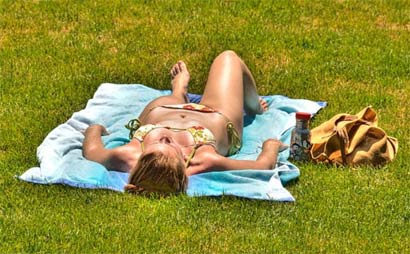 As human beings we love the sun. That warm, burning globe that brings us light, warm weather and a wicked tan can do more than make you look good. In Western society we place high value on having a ‘healthy glow’; enough that many people will pay to sit in a bed of lightbulbs to get it.
As human beings we love the sun. That warm, burning globe that brings us light, warm weather and a wicked tan can do more than make you look good. In Western society we place high value on having a ‘healthy glow’; enough that many people will pay to sit in a bed of lightbulbs to get it.
But are you being safe? Skin cancer is more prevalent than ever and the leading cause is too much sun-worshipping.
As young people we tend to ignore the advice our parents give us in favour of what our friends are doing. We also forget things like putting on sunscreen before we go outside because we’re dying to get that bronzed skin that we see celebrities sporting on television. Even if you do remember the sunscreen you need to make sure that you’re using the right product. There are a lot of different options on the market and it’s better to play it safe, says Teen Vogue:
In a perfect wellness world, there would be a college course devoted to skincare with a midterm exam on sunscreen. Because every year, when the Environmental Working Group’s sunscreens guide drops, we always learn something new.
That’s happening today, with the debut of the EWG’s 10th annual guide, which famously lists the organization’s picks for best and worst sunscreens. They review hundreds of products, scanning the label for clean and not-so clean ingredients (such as known hormone disruptors and allergens), and give each product a toxicity rating, with a score of 1 being the best.
Because nobody wants to unknowingly put crap on their skin — or stay indoors all summer, we chatted with EWG senior analyst Sonya Lunder about the key things you should know about sun protection right now. —Additional reporting by Rachel Lapidos
Here are 10 things you might be surprised to know about sunscreen — but totally should — and non-toxic EWG product picks:
- You’re probably not putting enough sunscreen on.
Mineral sunscreens like zinc oxide and titanium dioxide are typically thicker in appearance, so people often think they are putting on enough when they’re actually not. Pay closer attention when using these sunscreens to ensure you’re properly covered. The Skin Cancer Foundation says 1 ounce (get out your shot glass), every two hours. You should drain half a bottle on a long beach day.- Look out for oxybenzone.
It’s a very common ultraviolet filtering ingredient used in many sunscreens, but it’s also a hormone disruptor and an allergen, says Lunder. EWG found it in 70{d37354aaad759975ec124ada39953ac966a67b9395d680228aae703217594375} of non-mineral sunscreens they evaluated this year. You might want to reach for sun protection with zinc oxide and titanium dioxide (both minerals), which are considered safer sunscreen ingredients.Via: http://www.teenvogue.com/story/sunscreen-facts-you-should-know
We have one body. Science is not advanced enough to replace our entire physical body if we ruin it. You’ve probably heard your parents or family members remind you that you only live once and that you need to take care of yourself. As we age we also gain more responsibility for our actions. Even if “growing up” is not high on your list, when it comes to your skin and taking care if it you should do everything in your power to do it right.
